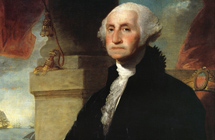你在学校里学到的这6个“事实”已经不再准确
|
THEN: America won its independence on July 4, 1776 NOW: America was not officially independent until seven years later, in 1783. Every year on July 4, Americans celebrate Independence Day with parades, barbecues, and fireworks. But while the Declaration of Independence was adopted by 12 colonies on July 4, 1776 and signed by 13 colonies in August, America was not yet free from Great Britain's rule. The American Revolution waged on for years. Finally, the Treaty of Paris was signed on September 3, 1783, and America became free.
THEN: George Washington's teeth were made of wood NOW: Washington's teeth were human teeth from his slaves and also made from ivory. A set of dentures that George Washington wore are kept at the Mount Vernon plantation house museum. The dentures are fashioned out of ivory and human teeth. While historians note the "limitations of history" when sourcing Washington's human teeth back to the individuals they were taken from, written evidence shows Washington purchased teeth from slaves and made note of it in one of his ledgers. Slaves during the 18th century sometimes sold their teeth to dentists to make money. In 1784, Washington "paid several unnamed 'Negroes' ... 122 shillings for nine teeth, slightly less than one-third the going rate advertised in the papers," according to PBS. Washington likely then had the teeth implanted into his jaw in a surgical procedure common at the time. THEN: Pluto is a planet NOW: Pluto isn't a planet We've known since the late 1800s that a ninth planet, after Uranus, potentially existed. In 1906, Percival Lowell, the founder of the Lowell Observatory in Flagstaff, Arizona, even began a research project intended to locate the mysterious "Planet X." Then in 1930, a 23-year-old newbie at the facility found it. The discoverer, Clyde Tombaugh, had been tasked with systematically comparing photographs of the sky taken weeks apart to search for any moving objects. He eventually saw one and submitted his finding to the Harvard College Observatory. After an 11-year-old English girl named the new planet (for the Roman god of the underworld), we started including Pluto as a planet in our solar system. But in 2003, an astronomer found a larger object beyond Pluto — which he named Eris, according to NASA. The new information caused a bunch of other astronomers to question what really makes a planet a planet, and they decided, based on size and location, that Pluto just didn't make the cut. Neither did Eris, actually. Pluto was demoted to a dwarf planet. Needless to say, elementary schools kids were pretty bummed. But there may be hope. Researchers have recently been debating whether to make Pluto a planet again.
NOW: They were actually hanged Even if you didn't read Arthur Miller's "The Crucible" in high school, you probably learned somewhere that the townspeople of Salem burned witches at the stake. But that never happened, according to Richard Trask, a town archivist for Danvers (formerly known as Salem Village.) He also chaired the Salem Village Witchcraft Tercentennial Committee from 1990 to 1992 and wrote a book detailing the time period called "Salem Village Witch Hysteria." At the time of the trials, New England still followed English law, which listed witchcraft as a felony punishable by hanging — not burning at the stake, Trask said. In Europe, however, the church labeled witchcraft heresy and did tie up suspected practitioners and light them on fire. You can see where the confusion started.
NOW: Egyptians workers built the pyramids themselves Even movies like "The Prince Of Egypt" perpetuate the idea that slaves built the pyramids. Although many think the Bible tells us they did, the book doesn't mention the story specifically. This popular myth reportedly stems from comments made by former Israeli Prime Minister Menachem Begin when visiting Egypt in 1977, according to Amihai Mazar, professor at the Hebrew University of Jerusalem. "No Jews built the pyramids because Jews didn't exist at the period when the pyramids were built," Mazar told the AP. Recent archaeological finds actually show that Egyptians built the pyramids themselves. Workers were recruited from poor families in the north and south but were highly respected, earning crypts near the pyramids and even proper preparation for burial. Slaves wouldn't have been treated so honorably. THEN: The Great Wall Of China is the only man-made structure visible from space. NOW: Many man-made places are visible from space. Technically, this wasn't ever a solid "truth" — just a fact third-graders ubiquitously included in their class reports. In fact, rumors that you can see the landmark, not only from a spaceship, but all the way from the moon, date back as far as 1938. In 2003 though, the first Chinese astronaut finally shattered the myth. The party responsible, a man named Yang Liwei, admitted he couldn't see the Great Wall from space. Other photos surfaced here and there. The consensus became that you can, indeed, catch glimpses of the Great Wall but only under the right conditions (snow on the structure) or with a zoom-capable camera. You can also see the lights of large cities — and major roadways and bridges and airports and dams and reservoirs. "The only thing you can see from the Moon is a beautiful sphere, mostly white, some blue and patches of yellow, and every once in a while some green vegetation," Apollo 12 astronaut Alan Bean told NASA. "No man-made object is visible at this scale." To further clarify, people probably mean these structures are visible from satellites orbiting Earth — but that's not actual space. |









